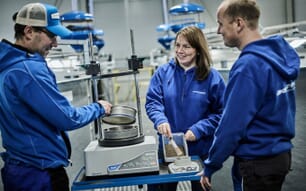In 2012, world aquaculture produced 66 million tons of fish, outstripping the beef industry by 3 million tons. Such an event is not coincidence but the consequence of grain market trends, health education and a growing need to source food more sustainably, according to a report from the Earth Policy Institute.
The reason the EPI gives for the trend stems from the limited capacity of the rangelands and the oceans in providing protein over the second half of the twentieth century as global demand skyrocketed after the Second World War.
Since 1950, beef production and wild fish catch had increased fivefold by 1980 to meet growing demand. This left annual beef production at 50 million tons and global wild fish hauls at 90 million tons.
However, this left wild fish stocks low and vast areas of grassland overstocked. And, according to Janet Larsen and J Matthew Roney of the EPI is why fish farming developed so rapidly as an industry.
“The bottom line is that getting much more food from natural systems may not be possible. Much of the world’s grassland is stocked at or beyond capacity, and most of the world’s fisheries are fished to their limits or already crashing.”
“Overexploited fisheries are less readily visible, but fishing patterns over time reveal that more effort is required to achieve the same size catch as in years past. Boats are using more fuel and travelling to more remote and deeper waters to bring in their haul. Fishers are pulling up smaller fish, and populations of some of the most popular food fish have collapsed.”
As a result of dwindling supplies, farming fish has become a necessity, although it is not purely down to supply fears. It is partly down to the merits of fish species.
One EPI factor for allowing aquaculture to develop is the feed efficiency of fish in converting feed into meat.
In fact, fish are becoming easier to fatten as a protein animal as technological and nutritional advancements allow aquaculture to progress, this is partly to explain for a rising global output of six per cent a year over the last five years.
When compared to beef, which has barely increased, and pork, up around 1.7 per cent, this is a telling statistic for the cattle industry which has been faced with historically high grain costs following extreme weather events.
“Cattle consume 7 pounds of grain or more to produce an additional pound of beef,” say EPI researchers. “This is twice as high as the grain rations for pigs, and over three times those of poultry.”
Fish are far more efficient, typically taking less than 2 pounds of feed to add another pound of weight, added the team.
This has come home to roost in recent years when extreme weather events have led to global grain availability scares. The report details the last major shortage in 2012 when the global grain harvest fell three per cent.
The EPI has reasoned that sliding on-farm profits caused costs to be passed on to consumers. This happened to coincide with health messages from science groups about red meat and the health benefits of eating fish.
However, dependence on fish farming is not a perfect alternative to grazing beef and fattening cattle in feedlots. There are inherent problems with some aquaculture systems which the EPI states require attention.
Carnivorous fish farming needs particular care. Salmon and Shrimp aquaculture requires vast quantities of ‘forage fish’ to operate, this is derived from wild populations of fish that are caught and turned into fishmeal or fish oil.
Key nations in these industries are Norway, the world’s largest farmed salmon producer and China, the leading Shrimp producer in the world. It is no chance thing that Norway is the largest importer of fish oil in the world and China currently imports almost a third of fishmeal traded each year.
Around one third of the world’s oceanic catch now goes back into the fish sector to be processed as fish meal or fish oil. Principal species are Anchovies, Herrings and Sardines which, according to the report are all ‘dangerously overharvested’.
Such a dependence on these species constitutes a danger to the planet, write Mrs Larsen and Mr Roney. This is why waste fish trimmings are being reused as feed and fish meal is currently 30 per cent by-products with livestock and poultry processing wastes used to feed plant-based fish feeds.
So the answer, according to analysts at EPI, is to consume less meat, milk, fish and eggs. The global population grows nearly 80 million each year and it is time to face up to the ‘inescapable' limits of nature.





